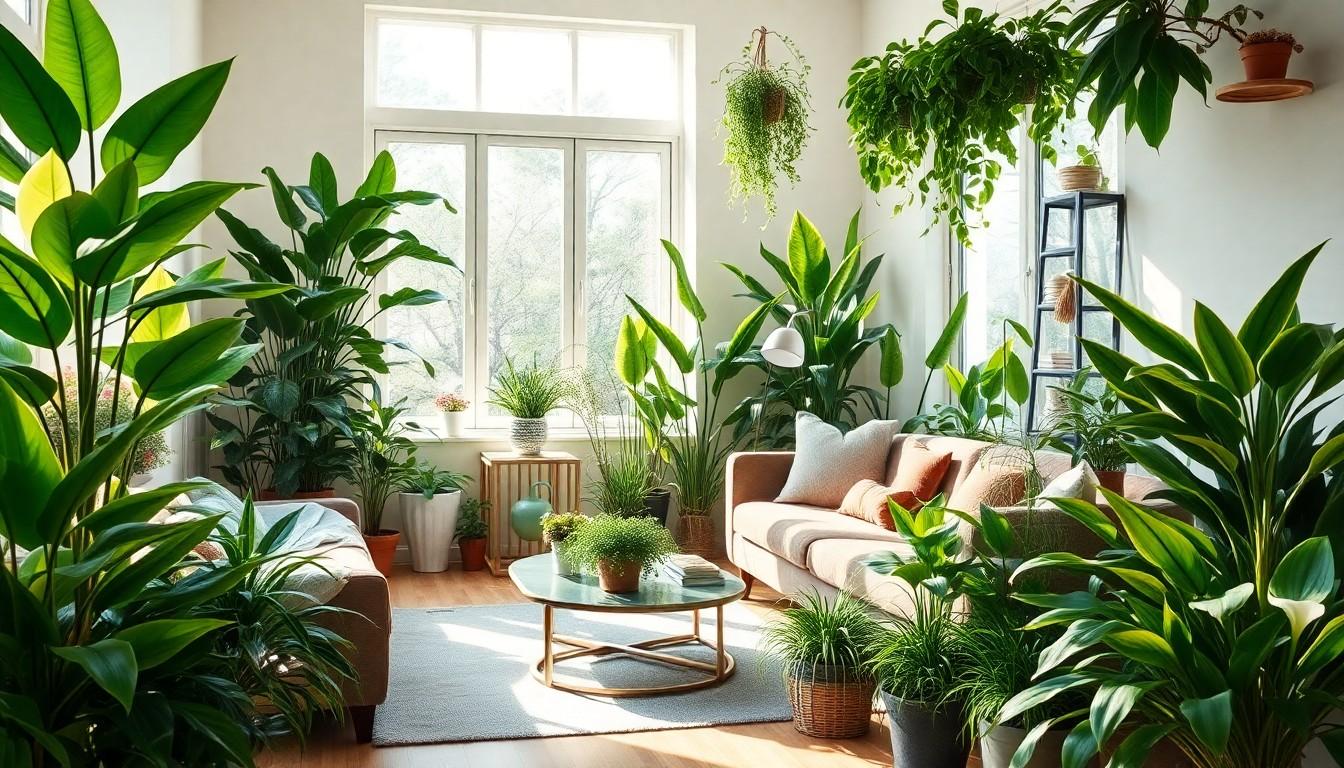Indoor plants aren’t just a pretty face; they can be your secret weapon for better health. Imagine transforming your living space into a lush oasis that not only looks good but also boosts your mood and purifies the air. Who knew that a bit of greenery could help you breathe easier and even reduce stress?
Best Indoor Plants for Health
Several indoor plants provide significant health benefits. Peace lilies purify air by removing toxins such as ammonia and formaldehyde. They thrive in low light and require minimal care, making them suitable for various indoor spaces.
Spider plants contribute to air quality by absorbing carbon monoxide and releasing oxygen. Their resilience allows them to adapt to different environmental conditions. Regular watering encourages growth, promoting a healthier atmosphere.
Snake plants, also known as mother-in-law’s tongue, feature extensive air-purifying qualities. They convert carbon dioxide into oxygen during nighttime, improving indoor air quality while promoting better sleep patterns. These plants tolerate neglect and thrive in low-light areas.
Aloe vera not only serves as a natural remedy but also enhances wellness. This succulent releases oxygen and humidifies air, contributing to respiratory health. Understanding its requirements helps maximize its benefits in living spaces.
Boston ferns act as natural humidifiers, combating dry air and improving overall comfort. They flourish in humid conditions, which makes them ideal for bathrooms or kitchens. Regular misting aids in keeping their foliage lush.
English ivy reduces airborne mold and allergens, promoting better skin and respiratory health. It’s easy to train along trellises, enhancing aesthetics. Placing it near windows increases its exposure to sunlight and maximizes its benefits.
Integrating these plants within living environments enhances both aesthetics and health. By selecting the right indoor plants, individuals can create a more vibrant and health-conscious home.
Benefits of Indoor Plants

Indoor plants contribute significantly to health and well-being. They offer various physical and psychological advantages.
Air Quality Improvement
Indoor plants improve air quality by filtering pollutants. Research shows that certain species, like peace lilies and spider plants, remove harmful toxins such as formaldehyde and benzene from the air. Each plant type has unique properties that enhance oxygen levels. For instance, snake plants release oxygen even at night, benefiting nighttime air quality. Improved air also leads to easier breathing, creating a healthier indoor environment. A study indicated that having just one plant per 100 square feet enhances the overall indoor atmosphere. Including various plants can maximize these benefits, promoting a cleaner and fresher living space.
Stress Reduction
Indoor plants help reduce stress levels significantly. Exposure to greenery has been linked to lower cortisol levels, a hormone associated with stress. Adding plants to workspaces or homes creates a calming effect, enhancing mental clarity and focus. Studies reveal that individuals with plants nearby report greater feelings of tranquility and satisfaction. Keeping plants, like aloe vera, around can evoke feelings of relaxation due to their soothing presence. Incorporating greenery into daily life can transform spaces into serene havens, allowing individuals to cope better with everyday stresses.
Aesthetic Appeal
Indoor plants enhance the aesthetic appeal of living spaces. They add color and texture to any environment, creating visually stimulating areas. A well-placed plant can serve as a focal point that draws attention and adds character. Varieties like Boston ferns and English ivy offer beautiful foliage, elevating room design. Plants bring a sense of life and vitality indoors, making spaces feel warm and inviting. Additionally, studies show that people feel happier and more productive in environments enriched with nature. Maintaining an assortment of plants can result in a vibrant atmosphere conducive to overall well-being.
Top Indoor Plants for Health
Indoor plants contribute significantly to well-being. The following plants offer remarkable health benefits.
Snake Plant
Snake plants thrive in low light and require minimal care. Notably, they generate oxygen at night, improving air quality during sleep. Additionally, they filter out harmful toxins like formaldehyde and benzene. Growing one snake plant can enhance air purification in an average-sized room. Over time, their presence leads to better breathing and restful nights.
Peace Lily
Peace lilies are renowned for their air-purifying abilities. They effectively eliminate indoor pollutants, including ammonia and acetone. The humidifying properties of peace lilies also promote a balanced indoor environment. A single peace lily can detoxify air in a space up to 100 square feet. Their calming beauty adds to the aesthetic appeal while positively impacting mental health.
Spider Plant
Spider plants adapt well to various indoor environments and are easy to care for. They excel at absorbing carbon monoxide and releasing oxygen, making the air fresher. Moreover, spider plants remove harmful substances like formaldehyde and xylene. Keeping a few spider plants in the home elevates air quality significantly. Their attractive arching leaves also provide visual interest.
Pothos
Pothos plants are popular for their resilience and beautiful trailing vines. They purify the air effectively by filtering out formaldehyde and other toxins. Regularly caring for pothos by watering them enhances both visual appeal and air quality. A well-placed pothos plant can elevate any living space. Their low-light tolerance and minimal care requirements make them a favorite choice.
Aloe Vera
Aloe vera serves dual purposes as a health enhancer and a beautiful indoor plant. This succulent releases oxygen and humidifies the air, contributing to a healthier environment. Its soothing gel also aids in treating minor burns and skin irritations. Placing an aloe vera plant near a window ensures optimal growth and benefits. Regular care prompts robust growth while enhancing indoor wellness.
Tips for Caring for Indoor Plants
Caring for indoor plants involves understanding their specific needs. Healthy plants thrive when provided with suitable lighting, watering routines, and nutrient-rich soil. Additionally, a printable poster with care instructions can serve as a helpful reference for maintaining plant health.
Light Requirements
Different plants require varying amounts of light. Snake plants flourish in low light conditions, making them ideal for dim rooms. Peace lilies prefer indirect light, while spider plants adapt well to bright, filtered sunlight. Positioning plants according to their light needs promotes optimal growth. Assessing the light quality in each room helps determine suitable plant placements. Use sheer curtains to diffuse harsh sunlight for sensitive species.
Watering Needs
Watering frequency changes based on plant type and environmental conditions. Most indoor plants prefer soil that dries slightly between waterings for healthy roots. Peace lilies indicate thirst with drooping leaves; watering promptly restores their perkiness. Overwatering leads to root rot, a common issue with many houseplants. Touching the soil a few inches down effectively checks moisture levels. Adjusting the watering schedule seasonally can help maintain proper hydration.
Soil and Fertilizer
Using the right soil blend ensures proper drainage and aeration. Many indoor plants thrive in potting mixes designed for houseplants. Incorporating organic matter enhances nutrient content. Fertilizing during the growing season supports healthy leaf and root development. Liquid fertilizers provide quick nutrient absorption, while slow-release options nourish over time. Analyzing specific plant needs guides fertilizer selection.
Positive Impact of Greenery
Bringing indoor plants into a home not only enhances its beauty but also promotes a healthier lifestyle. The right selection of plants can significantly improve air quality and reduce stress levels. By choosing resilient varieties like snake plants and peace lilies, individuals can create a serene environment that supports overall well-being.
Caring for these plants is essential to maximize their benefits. With proper light and watering routines, anyone can enjoy the positive impact of greenery in their living spaces. Incorporating these plants is a simple yet effective way to foster a vibrant and health-conscious atmosphere at home.

